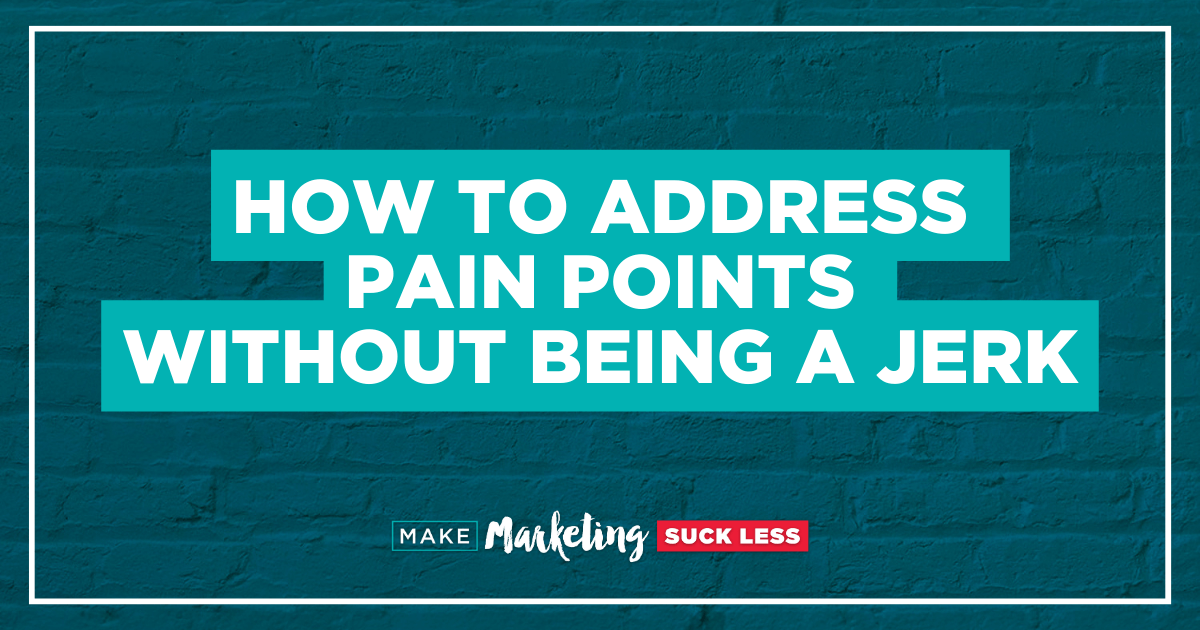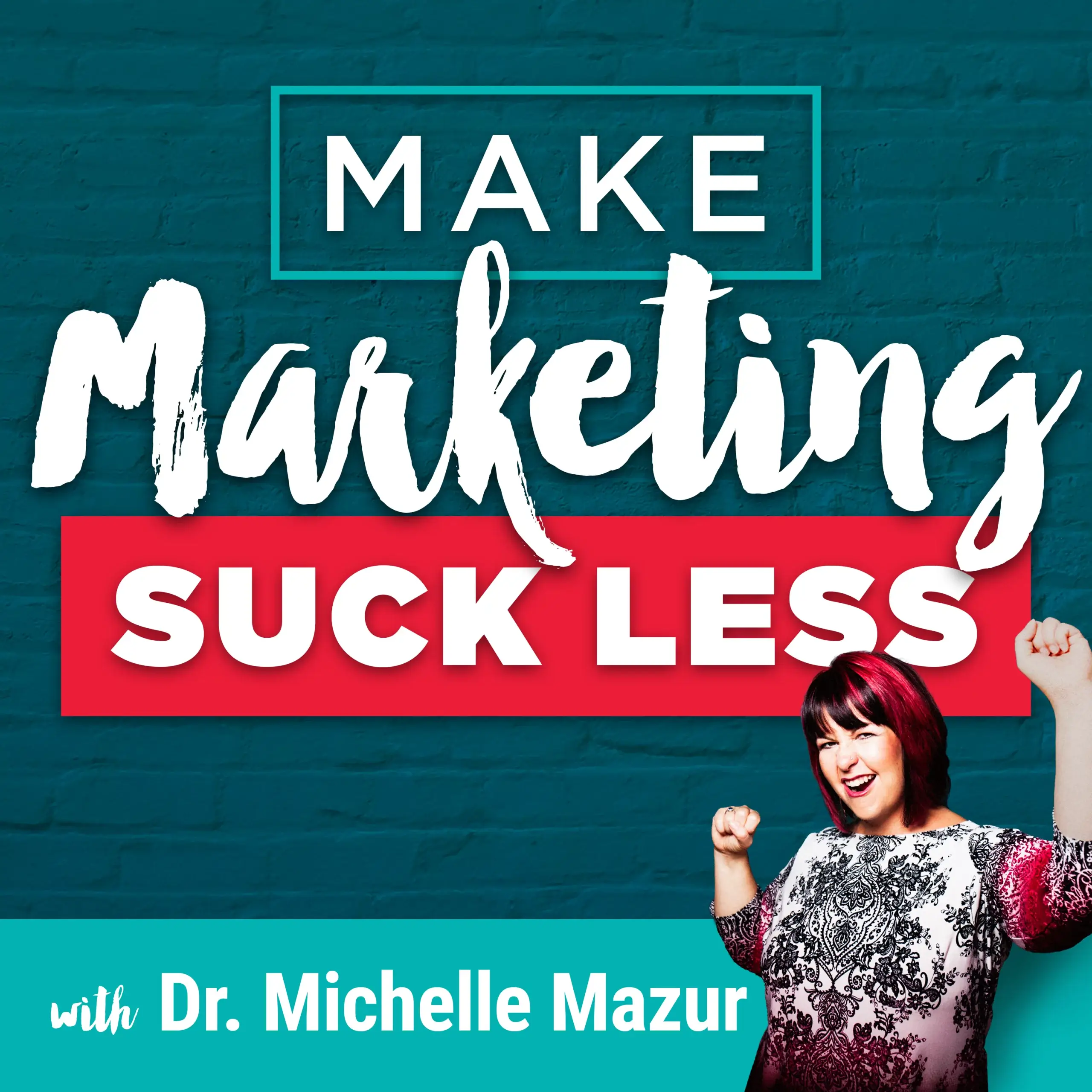Make Marketing Suck Less
How To Address Pain Points Without Being A Jerk
By Michelle Mazur > February 6, 2024
Filed Under Podcast

Do you hate the idea of pressing on people's pain points?
Agitating the pain so that the only solution to make it stop is by giving you money?
I do too. It's gross. It's icky, and, unfortunately, it works.
But there's another way to talk about your clients' struggles and challenges without feeling like a big old sleazeball.
It's key to creating your minimum viable marketing message and ensuring your potential clients feel seen, heard, and valued.
So what is this alternative?
You'll just have to listen in to find out.
(Click play or read the transcript below.)
In this episode we…
- review what the hell messaging is and the voice of customer research
- work to understand the pain your client is experiencing
- learn the three parts of the Problem Statement, including how to stop the “snake from eating its tail” problem
Learn more about Michelle Mazur:
Resources mentioned:
- What the hell is messaging and why does your business need it?
- Tapping into the customer awareness spectrum to market with intention
- Duped: The dark side of online business
Listen on your favorite podcast player or read the Transcript below:
Michelle Mazur [00:00:00]: Do you hate the idea of pressing on people's pain points? Agitating the pain so that the only solution to make it stop is by giving you money? Ugh. I do too. It's gross. It's icky, and, unfortunately, it works. But there's another way to talk about your clients' struggles and challenges without feeling like a big old sleazeball. It's key to creating your minimum viable marketing message and also make sure that your potential clients feel seen, heard, and valued. So what is this alternative? You'll just have to listen in to find out. Michelle Mazur [00:00:52]: Welcome to Make Marketing Suck Less. The podcast that knows marketing is freaking hard, especially when you're a solo business owner trying to juggle it all. I'm your host, Dr. Michelle Mazur, author of the 3 Word Rebellion and founder of the Expert Up Club. Forget the latest marketing fads and tactics promising social media stardom. I'm here with research-backed strategies to help you clarify your message and get twice as effective with your marketing. And while I can't promise you'll ever love marketing, I'm here to make you hate it a tiny bit less. Michelle Mazur [00:01:32]: The way that we talk about people's pain points and struggles often leaves a lot to be desired. Because if you push on pain points too much, you're at risk for triggering people's trauma response and making them feel like shit about themselves. This is such a tricky and nuanced dilemma. And that's why I wanted to talk about this in our deep dive into creating your minimum viable marketing message. So the first episode in the series, we talked about what messaging is, how it works, the job it does for your business. And then on our last episode, we talked about voice of customer. And I wanted to say something about that. If you have not listened to the voice of customer episode, go do it now because figuring out how to talk about your clients problems starts by talking to your clients. Michelle Mazur [00:02:37]: Alright. So let's talk about the problem with problems. So number one I've already alluded to, pressing on pain points. And if you listen to Duped or this podcast, you know I am not a fan of - and I'm also not a fan of going 100% in the other direction either, with not talking about a person's pain points. But instead, there is this nuanced middle ground where we're really empathizing with the persons struggle. So for me, the difference between the two is like this. When you're pressing on somebody's pain points. It's like seeing a person with a broken leg and walking up to them and kicking them heatedly in the leg until they pay you to stop. Whereas if you see someone with a broken leg and you go out to them, and you acknowledge the broken leg, you acknowledge how they must be feeling, you find out like, oh, What happened? Oh, I'm so sorry that this happened for you. Does it hurt? That's different. Right? That is empathy. So acknowledging is a very slight and nuanced way to address a pain point without being a jerk about it. Now I know you might not want to do this. But you have to speak to your client's experience because here's a mistake I see. People rebel against pain point marketing. They don't wanna do it. It's gross. It's icky. Yes. I get that. Let's not do it. So what they do is they strip all talk of a person's pain, their struggles, their challenges from their marketing copy. They go 100% the opposite direction, and I get why they do that. Like, you don't want people to feel bad or shameful or in more pain, but then something else happens. It becomes toxic positivity, were not acknowledging a person's very real experience. And then people don't know why they should buy. Right? We buy things to solve problems. So if you're not talking about the problem because you don't wanna be gross or icky, then people don't know why they should buy. Michelle Mazur [00:05:12]: So that's the first problem with problems. The second problem that I see is a little less on that gross and icky scale, but I call it the snake eating its tail problem. So one of the things I have seen over the years is that people define the problem their client has in terms of their solution. So let's say I'm a goal setting coach. The problem I solve for you is you don't have goals. I'm a message strategist. The problem I solve is you don't have a message. I'm a website designer. The problem I solve is you need a website. And those things aren't actually problems. Not having goals might not actually be a problem or a message or a website. When we're defining a problem in terms of a solution, it's not speaking to your client's experience. The problem your client is facing typically doesn't have anything to do with your solution. No one is staying up at night and thinking, damn, I need a message. They are thinking, damn, my launch flopped. Man, my audience isn't growing. Sure, that's a problem that messaging can solve, but that is the challenge or struggle. So be sure the way that you're talking about someone's challenges, their struggles, is not just pointing out that they don't have your solution. So how do we approach pain points differently so that they're not pressing on the pain and it's not the snake eating its own tail? So inside the Expert Up Club, the way I teach you to create a message that addresses your clients experience that actually empathizes and doesn't do harm is something that I call a problem statement. Michelle Mazur [00:07:25]: A problem statement has three parts. Part one is the presenting issue or the presenting symptoms. I like to think that it has symptoms, so, like, what's happening to them. Part two is the impact of those symptoms, so the ripple effect of that symptom. And then finally, we can get to the root cause, and this is where you are bridging the gap between what their experience is and how to know if they need your solution. So it's a little bit of a diagnostic. Right? So let me give you an example of this from my own business. One of the biggest issues that I'm seeing especially inside the Expert Up Club is audience growth. So many of my members have more leveraged offers. So their presenting problem is, I have this great group program. Like, I launched it once. My clients got great results. It went really well. And then I launched it a second time, and I didn't get anyone or I didn't meet my goals. And it's like, oh, okay. Like, that is the presenting problem. Right? They had a launch. It flopped, and they don't really know why. And so as I'm talking to them in my marketing, I can then talk about, like, okay. So what is the impact of a flop launch? Right? And what I see, what my voice of customer research tells me is sometimes people think that their program sucks. Like, their program is the problem. And let me tell you, my friends, if you had a great first launch and your clients are getting great results from that program, the program is not the problem. It is typically your audience size. Like, you did not have enough people to launch it to. So the impact that we go into, it's like, alright. They're feeling less than confident about their program. They're experiencing the dip in revenue. They're not sure, like, what they should do next or what should they try in order to solve this problem. Right? So it has a lot of different impacts, and then I can get them into the solution around well, let's talk about, like, how big your audience is. And maybe it's not a failure of your launch or the program, but you just didn't have enough people to sell it to. And what does it take to sell a program? Well, you need to market, and you're gonna need a message that actually attracts people to the work you do to grow the audience. Right? So we finally got there. And that's just one example, but I base all the problem statements off of my voice of customer research. Michelle Mazur [00:10:34]: Now if you want to create a problem statement for your business, the best place to do that is in the Expert Up Club. We are currently accepting new members. Right now, we are working on creating the minimum viable message in the club. So it's a perfect time to jump in and join us so that you can create a problem statement that's not pressing on pain points, but actually empathizing with people and gets them to take the next step to see if your solution is what is right for them. So your next step is to book a private tour of the Expert Up Club. Let me show you around and tailor the tour to you so you can see if the Club is the place for you to become a recognized leader and grow your audience. So you can book a tour at expertup.club and solve your problem with problems by creating a problem statement that empathizes and resonates with your potential client's experience. Michelle Mazur [00:11:49]: If the Make Marketing Suck Less pod is making your marketing more effective so that your clients can find and hire you, please share the show with a friend. The easiest way to do that is through pod link. You can find the show at pod.link/rebel, and that page will allow anyone you share the show with to subscribe and start listening in their favorite podcast player. That's pod.link/rebel. The Make Marketing Suck Less podcast is a production of Communication Rebel. Our production coordinator is Jessica Gulley-Ward. The podcast is edited by Steven Mills, our executive producer is me, Dr. Michelle Mazur. The make marketing suck less podcast is recorded on the unseated traditional lands of the coast salish peoples, specifically the first people of Seattle, the Duwamish people, original stewards of the land, past, and present.
Enter your name and email address below and I'll send you periodic updates about the podcast.
Sign up to receive email updates
Create Your One-of-a-Kind Message
Your 3 Word Rebellion is the Key to Growing Your Business & Impact






